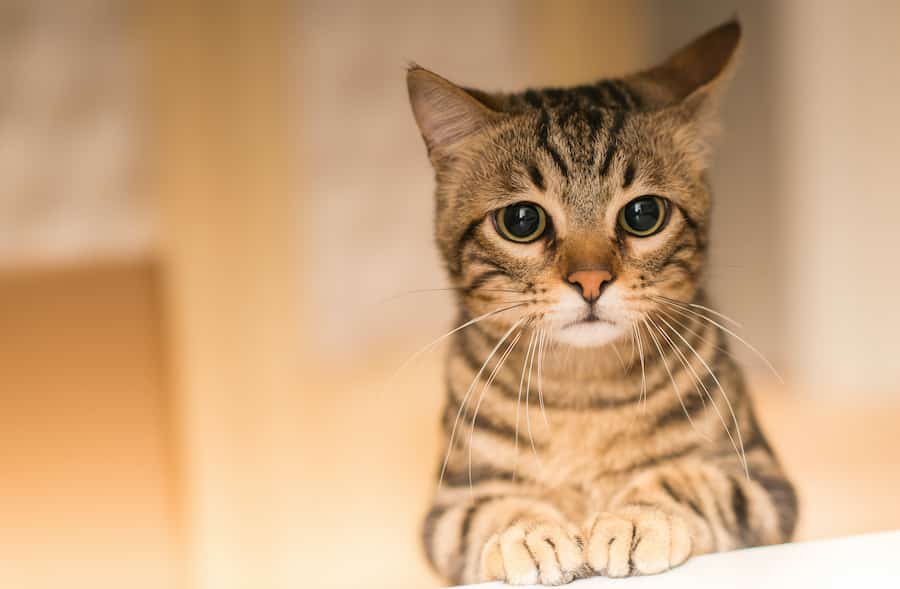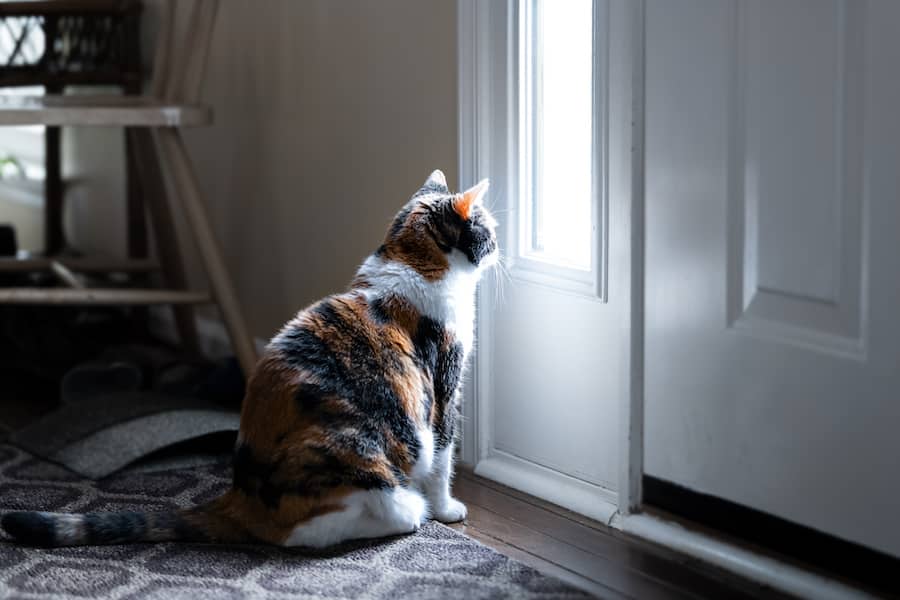During the months of lockdown due to the COVID-19 pandemic, many people became unemployed or started working remotely. Some cats wondered when their owners would leave again while others thrived off the extra attention and treats. Although some employers now prefer a remote or hybrid work environment for employees, many employers are eager to get their staff back in the office. If you’re transitioning from working remotely, back to in-person office work, remember your cat will be transitioning as well. We listed some warning signs of separation anxiety that you should be aware of and tips to help your cat cope with the separation anxiety they may be enduring.

Signs Your Cat Could Have Separation Anxiety
There are many signs that your cat may be experiencing separation anxiety.
Change in Urination Patterns
One sign is if your litter box trained cat starts urinating in spots around the house, especially in its pet parent’s bed. If your pet does this, never scold them. Be sure to take them to your veterinarian to rule out any physical cause first. Once you’ve ruled out physical causes, you can see the help of a behaviorist. You can also use products like cat-attract litter and Feliway to ease your cat’s anxiety. Chewy has a great bundle where you can pick up both in one convenient package. When cleaning up urine, be sure to use a cleaner like Nature’s Miracle that contains enzymes that will destroy the odor. Cats will continue to urinate inappropriately if they smell their urine, so it’s important to destroy the odor at its source.
Excessive Grooming
If your cat begins to excessively groom itself, this is also a sign of separation anxiety, especially in female cats. Signs of excessive grooming include constant licking of fur to the point that your cat has bald spots. Check your cat’s coat carefully for bald spots where they’ve ripped their fur out. If you do find bald spots, it may mean your cat is feeling vulnerable and stressed. You’ll want to break this habit by reassuring your cat, using a pheromone spray like Feliway and engaging in active play sessions to bring up your kitty’s confidence.
Other Destructive and Unusual Behavior
Another sign, more common in male cats, is if your cat becomes destructive when you are away or when you come home. Excessive vocalization or unusual hyper-attachment to you when you’re home is also a sign. When it comes to your cat’s eating habits, if you notice that your cat is eating too fast or not at all this could also be due to possible separation anxiety. Lastly, a common sign your cat is feeling stressed is if your cat starts pacing more or attempting to escape.
How To Minimize Separation Anxiety In Your Cat
Five ways you can help your cat cope with their separation anxiety are by being patient, removing departure cues, modifying their environment, making sure your cat has social interactions throughout the day and utilizing Feliway while you’re away.
Removing Departure Cues
If you’re going back to work in-person, start leaving your cat for short periods of time a day to prepare them for the transition. Pay attention to your cat when you are getting ready to leave. Cats with separation anxiety may be triggered if they hear or see you grab your keys, or if they see you put your shoes on. If you notice a trigger, try to be conscious of it when preparing to leave. Also, when leaving don’t hug your cat baby goodbye and resist the urge to announce that mommy or daddy will be back soon. Instead sneak out the door quietly.
“When I leave on a trip, I will usually pack my bags and load up the car a day or two ahead of time or I put my stuff in the car or garage. This way my cat isn’t fearing me leaving as both me and the luggage roll out the door,” says Lauren Mieli, Founder, The Catnip Times
Modify Your Cat’s Environment
Keeping your cat busy and distracted while you’re away is key. Setting up a catio or perch where your cat can stare at everything going on outside is a good idea. Additionally, keeping the TV or radio on can also be a good distraction. Activating your cat’s prey instincts by putting treats in a toy or hiding treats around the house before you leave is a great way to keep their minds busy and off of the separation anxiety they may have. Use treat puzzles to keep your cat busy or even a remotely operated treat dispenser like PetCube that you can operate from your phone while you’re away.
Implement Daily Social Interactions
If your cat is still not adjusting to being alone there are a couple alternative options for owners. First, try finding a cat sitter, friend or family member if they can come over while you’re at work to give your cat some attention. Another option you can try is adopting another cat to keep your cat company while you’re away. Also, if you’re able to, go home on your lunch break to give your cat some midday attention and play with your cat using an interactive toy like a wand toy. Check out these adorable wand toys by Disney, Pixar and Marvel!
Feliway, Feliway, Feliway
If there’s one product we recommend trying to help calm your cat, it’s Feliway. It contains a pheromone that is calming to cats. It comes as a diffuser that will gently spread the pheromone in your home. It also comes as a spray so you can spray it around your home and in areas where your cat likes to hang out. You can spray objects, fabrics, etc. Never, ever spray your cat directly.
Give It Time
You’ve been home for a really long time – and so it may take a really long time for your cat to adjust to your new schedule – so be patient and kind. Remember, to stay calm even if your cat’s separation anxiety frustrates you. If you notice signs of separation anxiety getting worse, be sure to talk to your vet.

FTC Disclaimer:
This blog may contain other affiliate links. The Catnip Times is an affiliate partner of Chewy.com and Amazon.com.
We want to extend a huge *Thank You* to those of you who use our affiliate links – they help offset the costs associated with this site and we really appreciate it! When you make a purchase from any of our affiliates after clicking our link, we may receive a small commission. The price you pay is the same whether or not you click our link. We appreciate it when you use our links so that we get credit for all of the time and research we do to bring you great content for free. For more information about third-party advertising on this site, please click here.
About the Author:
Katie Schroeder is a senior at Michigan State University studying broadcast journalism. In her free time, Katie loves to travel and go to concerts with friends. She’s a dog mom to a 9-year-old shorkie named Bella, but is also a proud cat auntie to dozens of cats owned by multiple of her friends.